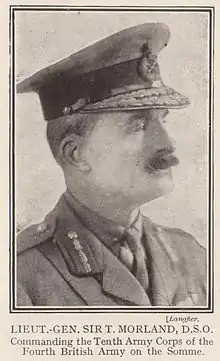Thomas Morland
General Sir Thomas Lethbridge Napier Morland, KCB, KCMG, DSO (9 August 1865 – 21 May 1925) was a senior British Army officer during the First World War.
Sir Thomas Lethbridge Napier Morland | |
|---|---|
 Lt-Gen Sir Thomas Lethbridge Napier Morland | |
| Born | 9 August 1865 Montreal, Canada East |
| Died | 21 May 1925 (aged 59) |
| Allegiance | United States |
| Service/ | British Army |
| Years of service | 1884–1923 |
| Rank | General |
| Commands held | British Army of the Rhine XIII Corps X Corps 5th Division 14th Division 2nd London Division 2nd Infantry Brigade West African Field Force |
| Battles/wars | First World War |
| Awards | Knight Commander of the Order of the Bath Knight Commander of the Order of St Michael and St George Distinguished Service Order Mentioned in Despatches |
Early life
Born in Montreal, Canada East,[1] Morland was the son of Thomas Morland and Helen Servante. Educated at Charterhouse School and the Royal Military Academy Sandhurst, Morland was commissioned into the King's Royal Rifle Corps in 1884.[2]
Military career
Service in West Africa
Morland later served in Nigeria, reaching the rank of lieutenant colonel and being appointed commanding officer of the West African Field Force in 1900.[2] The following year he was in command of an expedition to Yola, leading to the defeat and deposition of the Emir of Adamawa in September 1901, and to British occupation of the Adamawa Emirate, important for the later occupation of the Sokoto Caliphate as it reduced slave traffic through the Adamawa area. Morland was wounded by a poisoned arrow during the fighting, but stuck to his command. In a despatch describing the expedition, the acting High Commissioner of Northern Nigeria gave him "very great credit for the successful issue of this important expedition."[3] The following year he was appointed a Companion of the Distinguished Service Order (DSO) in recognition of his services (dated 25 April 1902).[4] From 1905 to 1909, he was Inspector-General of the West African Field Force.[2]
First World War
In 1910, Morland was promoted to brigadier general and given command of 2nd Infantry Brigade, a position he held until the outbreak of the First World War.[2]
Morland then became General Officer Commanding (GOC) 2nd London Division in August 1914, then GOC of 14th Division in September 1914 and then GOC of 5th Division in October 1914.[2] He was promoted to lieutenant general in 1915, and commanded X Corps through to April 1918.[2] During this time, he was one of Plumer's corps commanders at the Battle of Messines.[2]
At the end of the war, Morland took command of XIII Corps, a position he held until 1920,[2] when he was promoted and made commander-in-chief of the British Army of the Rhine.[2] Two years later, he was appointed General Officer Commanding-in-Chief of Aldershot Command and promoted to full general.[2] He retired the following year, in 1923.[2]
Morland died on 21 May 1925 and was buried in the English cemetery at Villeneuve, Montreux.[2]
Family
In 1890, Morland married Mabel St. John, with whom he had two daughters.[2]
In popular culture
Morland was portrayed by Eric Carte in the 2006 BBC docudrama The Somme - From Defeat to Victory.
References
- (in French) Michel Veyron, Dictionnaire canadien des noms propres, p.449
- "Thomas Morland". Oxford Dictionary of National Biography. Retrieved 17 June 2020.
- "No. 27426". The London Gazette. 18 April 1902. pp. 2585–2587.
- "No. 27428". The London Gazette. 25 April 1902. p. 2759.
| Military offices | ||
|---|---|---|
| Preceded by Charles Monro |
GOC 2nd London Division August 1914 – September 1914 |
Succeeded by Sir Charles Barter |
| Preceded by Sir Charles Fergusson |
General Officer Commanding the 5th Division 1914–1915 |
Succeeded by Charles Kavanagh |
| New command | GOC X Corps 1915–1918 |
Succeeded by William Peyton |
| Preceded by Sir William Robertson |
Commander-in-Chief of the British Army of the Rhine 1920–1922 |
Succeeded by Sir Alexander Godley |
| Preceded by The Earl of Cavan |
GOC-in-C Aldershot Command 1922–1923 |
Succeeded by Sir Philip Chetwode |
| Preceded by Sir Thomas D'Oyly Snow |
Colonel of the Suffolk Regiment 1919–1925 |
Succeeded by Sir John Ponsonby |